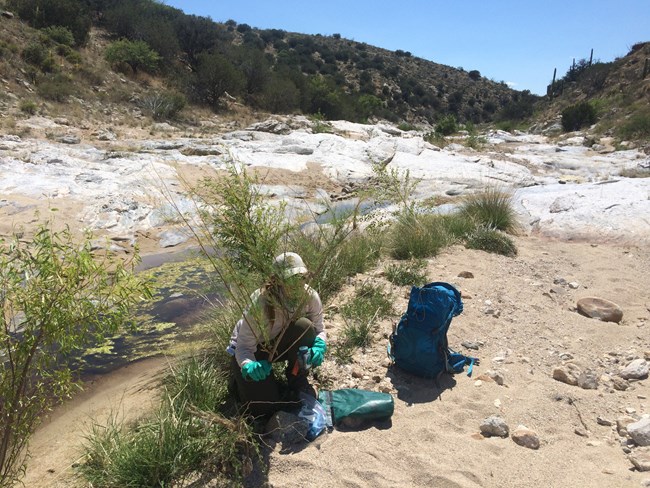|
Life in the desert exists in a delicate balance with the quantity and quality of water available. Changes in the watershed, the climate or the surrounding landscape impact how water moves from the land, into the streams and ultimately through the city of Tucson. Like a cascading set of dominoes, negative changes to water supply quickly impact the ecosystem at large, causing landscape-scale changes to the plants and animals. What are some of the largest threats to the water sources at the park? Invasive SpeciesOne of the largest threats to the park is the threat of invasive species, both plant and animal. Invasive species are non-native species that threaten to harm the ecosystem. Plants and animals that are brought to the region for human use or enjoyment may escape and thrive in the desert, posing a threat to native flora and fauna. 
NPS Photo PlantsThere are several exotic plant species of concern at Saguaro National Park. Most were introduced to the Tucson region either for cattle grazing or as ornamental gardening plants. Park staff are constantly fighting the battle to control their spread in the park and protect precious park resources. BuffelgrassBuffelgrass is a dense grass that was introduced for cattle forage in the 1930s. Buffelgrass grows densely between the sparse desert plants and can fuel large, hot fires to which desert plants are not adapted. These fires can lead to increased runoff and erosion, which in turn cause larger floods and damage the landscape. The park has a well-developed program to remove buffelgrass from within the park boundaries, but buffelgrass re-sprouts because it spreads from the neighborhoods in Tucson into the park. Beating buffelgrass is a community effort to eradicate it from yards, parks, roadsides, and the park.

NPS Photo TamariskTamarisk has devastated many river corridors in the southwestern United States, but Saguaro NP has largely escaped the damage. Before 2006, there were very few tamarisks growing in the park. But a large flood that year spread thousands of seedlings along Rincon Creek drainage from a few old, established trees upstream. Park staff manually removed thousands of seedlings and several large trees in the drainage, protecting the park from an epidemic. Quick action by park officials prevented a major outbreak. Although there are no established populations of tamarisk in the park right now, NPS staff are constantly monitoring the streams for new growth. 
NPS Photo AnimalsThe single largest invasive animal threat to aquatic species in the park is the American bullfrog. Although the bullfrog is native in the eastern United States, it has few predators in the West, allowing it spread out of control. Bullfrogs ravenously eat everything in their path and are carriers of (but not susceptible to) the chytridiomycosis, a dangerous fungus that kills amphibians, including lowland leopard frogs. In Tucson, bullfrogs live in golf-course water features, fountains, and backyard ponds. They pose a real threat to the populations of lowland leopard frogs still found in the park. Extreme WildfiresIn arid pine forests in the Southwest, wildland fires are a natural, normal part of the forest. They release nutrients back into the soil as well as open up the soil for new growth. However, decades of fire supression have led to the accumulation of fuel (brush, downed logs, etc.) and dense stands of trees. These conditions ate the perfect recipe for unnaturally severe fires. These extreme wildfires decimate vegetation and increase erosion and run-off. Tinajas further down stream that offer habitat for Sonoran mud turtles and lowland leopard frogs may be partially or completely filled with sand and soil from the burn area, eliminating the pools as habitat for several years. Climate ChangeFormer National Park Service Director Jon Jarvis declared that "climate change is fundamentally the greatest threat to the integrity of our national parks that we have ever experienced." Currently, our planet is critically changing. At Saguaro National Park, climate change means our droughts will likely be longer, temperatures will be warmer, and storms will be more intense. The vulnerability of the park's water resources will only be heightened by these changes. A drought-stressed landscape will be more susceptible to invasive species. Wildfires will be sparked more easily when fuel is dry. Intense precipitation will run-off more quickly instead of infiltrating into the soil. And thirsty cities will rely more heavily on groundwater supplies as surface water dwindles. There are things you can do to help conserve our water resources. |
Last updated: October 7, 2024
